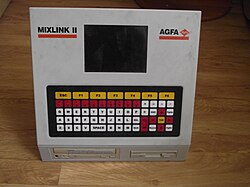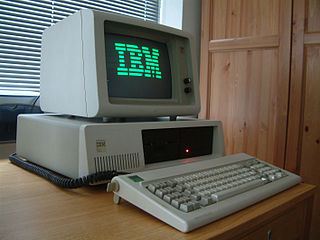This article relies largely or entirely on a single source .(November 2018) |
 Mixlink computer. |
Mixlink (Mixlink II) is a computer used with Agfa scales. [1] It was developed to facilitate calculation of color mixes.
This article relies largely or entirely on a single source .(November 2018) |
 Mixlink computer. |
Mixlink (Mixlink II) is a computer used with Agfa scales. [1] It was developed to facilitate calculation of color mixes.
Mixlink contains the Intel 80386 processor with the clock rate which may be set to either 9.2 or 33 MHz. The RAM size is 640 kB. The HDD function is served by the built-in flash memory that has the size of approximately 800 kB. Mixlink has the monochrome display.

The Intel 80386, also known as i386 or just 386, is a 32-bit microprocessor introduced in 1985. The first versions had 275,000 transistors and were the CPU of many workstations and high-end personal computers of the time. As the original implementation of the 32-bit extension of the 80286 architecture, the 80386 instruction set, programming model, and binary encodings are still the common denominator for all 32-bit x86 processors, which is termed the i386-architecture, x86, or IA-32, depending on context.
The clock rate typically refers to the frequency at which a chip like a central processing unit (CPU), one core of a multi-core processor, is running and is used as an indicator of the processor's speed. It is measured in clock cycles per second or its equivalent, the SI unit hertz (Hz). The clock rate of the first generation of computers was measured in hertz or kilohertz (kHz), the first personal computers (PC's) to arrive throughout the 1970s and 1980s had clock rates measured in megahertz (MHz), and in the 21st century the speed of modern CPUs is commonly advertised in gigahertz (GHz). This metric is most useful when comparing processors within the same family, holding constant other features that may affect performance. Video card and CPU manufacturers commonly select their highest performing units from a manufacturing batch and set their maximum clock rate higher, fetching a higher price.

A hard disk drive (HDD), hard disk, hard drive, or fixed disk, is an electro-mechanical data storage device that uses magnetic storage to store and retrieve digital information using one or more rigid rapidly rotating disks (platters) coated with magnetic material. The platters are paired with magnetic heads, usually arranged on a moving actuator arm, which read and write data to the platter surfaces. Data is accessed in a random-access manner, meaning that individual blocks of data can be stored or retrieved in any order and not only sequentially. HDDs are a type of non-volatile storage, retaining stored data even when powered off.
Mixlink is also staffed with CD drive and floppy drive.
Mixlink was intended to be used with the supplied floppy and CD disk, which provided the system environment ("operating system") and the application to be used for calculating color mixes. However, it is possible to install and run MS-DOS on Mixlink.

A floppy disk, also known as a floppy, diskette, or simply disk, is a type of disk storage composed of a disk of thin and flexible magnetic storage medium, sealed in a rectangular plastic enclosure lined with fabric that removes dust particles. Floppy disks are read and written by a floppy disk drive (FDD).

MS-DOS is an operating system for x86-based personal computers mostly developed by Microsoft. Collectively, MS-DOS, its rebranding as IBM PC DOS, and some operating systems attempting to be compatible with MS-DOS, are sometimes referred to as "DOS". MS-DOS was the main operating system for IBM PC compatible personal computers during the 1980s and the early 1990s, when it was gradually superseded by operating systems offering a graphical user interface (GUI), in various generations of the graphical Microsoft Windows operating system.
Currently, Mixlink computers are not used; their functions may solely be performed by personal computers (PCs).

A personal computer (PC) is a multi-purpose computer whose size, capabilities, and price make it feasible for individual use. Personal computers are intended to be operated directly by an end user, rather than by a computer expert or technician. Unlike large costly minicomputer and mainframes, time-sharing by many people at the same time is not used with personal computers.

The Apple II series is a family of home computers, one of the first highly successful mass-produced microcomputer products, designed primarily by Steve Wozniak, manufactured by Apple Computer, and launched in 1977 with the original Apple II. In terms of ease of use, features, and expandability, the Apple II was a major advancement over its predecessor, the Apple I, a limited-production bare circuit board computer for electronics hobbyists. Through 1988, a number of models were introduced, with the most popular, the Apple IIe, remaining changed relatively little into the 1990s. A 16-bit model with much more advanced graphics and sound, the Apple IIGS, was added in 1986. While compatible with earlier Apple II systems, the IIGS was in closer competition with the Atari ST and Amiga.

The Atari ST is a line of home computers from Atari Corporation and the successor to the Atari 8-bit family. The initial ST model, the 520ST, saw limited release in April–June 1985 and was widely available in July. The Atari ST is the first personal computer to come with a bitmapped color GUI, using a version of Digital Research's GEM released in February 1985. The 1040ST, released in 1986, is the first personal computer to ship with a megabyte of RAM in the base configuration and also the first with a cost-per-kilobyte of less than US$1.
The megabyte is a multiple of the unit byte for digital information. Its recommended unit symbol is MB. The unit prefix mega is a multiplier of 1000000 (106) in the International System of Units (SI). Therefore, one megabyte is one million bytes of information. This definition has been incorporated into the International System of Quantities.

The RadioShack TRS-80 Color Computer is a line of home computers based on the Motorola 6809 processor. The Tandy Color Computer line started in 1980 with what is now called the CoCo 1 and ended in 1991 with the more powerful CoCo 3. All three CoCo models maintained a high level of software and hardware compatibility, with few programs written for the older model being unable to run on the newer ones.

The Macintosh Plus computer is the third model in the Macintosh line, introduced on January 16, 1986, two years after the original Macintosh and a little more than a year after the Macintosh 512K, with a price tag of US$2599. As an evolutionary improvement over the 512K, it shipped with 1 MB of RAM standard, expandable to 4 MB, and an external SCSI peripheral bus, among smaller improvements. It originally had the same generally beige-colored case as the original Macintosh, but in 1987, the case color was changed to the long-lived, warm gray "Platinum" color. It is the earliest Macintosh model able to run System 7 OS.

The IBM Portable Personal Computer 5155 model 68 is an early portable computer developed by IBM after the success of the suitcase-size Compaq Portable. It was released in February, 1984, and was quickly replaced by the IBM Convertible, only roughly two years after its debut.

The Zip drive is a removable floppy disk storage system that was introduced by Iomega in late 1994. Considered medium-to-high-capacity at the time of its release, Zip disks were originally launched with capacities of 100 MB, then 250 MB, and then 750 MB.
A boot disk is a removable digital data storage medium from which a computer can load and run (boot) an operating system or utility program. The computer must have a built-in program which will load and execute a program from a boot disk meeting certain standards.

A USB flash drive, also known as a thumb drive, pen drive, gig stick, flash stick, jump drive, disk key, disk on key, flash-drive, memory stick, USB key, USB stick or USB memory, is a data storage device that includes flash memory with an integrated USB interface. It is typically removable, rewritable and much smaller than an optical disc. Most weigh less than 1 oz. Since first appearing on the market in late 2000, as with virtually all other computer memory devices, storage capacities have risen while prices have dropped. As of March 2016, flash drives with anywhere from 8 to 256 GB were frequently sold, while 512 GB and 1 TB units were less frequent. As of 2018, 2TB flash drives were the largest available in terms of storage capacity. Some allow up to 100,000 write/erase cycles, depending on the exact type of memory chip used, and are thought to last between 10 and 100 years under normal circumstances.

The Macintosh 128K, originally released as the Apple Macintosh, is the original Apple Macintosh personal computer. Its beige case consisted of a 9 in (23 cm) CRT monitor and came with a keyboard and mouse. A handle built into the top of the case made it easier for the computer to be lifted and carried. It had an initial selling price of $2,495. The Macintosh was introduced by the now-famous $370,000 television commercial by Ridley Scott, "1984", that aired on CBS during the third quarter of Super Bowl XVIII on January 22, 1984. Sales of the Macintosh were strong from its initial release on January 24, 1984, and reached 70,000 units on May 3, 1984. Upon the release of its successor, the Macintosh 512K, it was rebranded as the Macintosh 128K. This computer did not have a model number.

The X68000 is a home computer created by Sharp Corporation, first released in 1987, sold only in Japan.
The El Torito Bootable CD Specification is an extension to the ISO 9660 CD-ROM specification. It is designed to allow a computer to boot from a CD-ROM. It was announced in November 1994 and first issued in January 1995 as a joint proposal by IBM and BIOS manufacturer Phoenix Technologies.
The PocketZip is a medium-capacity floppy disk storage system that was made by Iomega in 1999 that uses proprietary, small, very thin, 40 MB disks. Its relation to the original Zip drive and disk is the floppy medium and relatively much higher capacity than standard floppy disks. It was known as the "Clik!" drive until the click of death class action lawsuit regarding mass failures of Iomega's Zip drives. Thenceforth, it was renamed to PocketZip. A 100 MB Pocket Zip drive version had been in the works, was intended to be backwards compatible with the 40 MB disks, but ended up being vaporware and PocketZip itself would be discontinued as well.
IMG, in computing, refers to binary files with the .img filename extension that store raw disk images of floppy disks, hard drives, and optical discs or a vector image – .img.
The Macintosh LC 500 series is a series of personal computers that were a part of Apple Computer's Macintosh LC family of Macintosh computers. It was Apple's mid-1990s mainstream education-market Macintosh, featuring an all-in-one desktop design with a built-in 14" CRT display, CD-ROM drive, and stereo speakers. Designed as a successor to the compact Macintosh family of computers, the case is similar to the then recently introduced Macintosh Color Classic, but considerably larger and heavier due to its larger screen and a bulging midsection to house the larger electronics.

A ROM cartridge, usually referred to simply as a cartridge or cart, is a removable memory card containing ROM designed to be connected to a consumer electronics device such as a home computer, video game console and to a lesser extent, electronic musical instruments. ROM cartridges can be used to load software such as video games or other application programs.

A floppy disk is a disk storage medium composed of a disk of thin and flexible magnetic storage medium encased in a rectangular plastic carrier. It is read and written using a floppy disk drive (FDD). Floppy disks were an almost universal data format from the late 1970s into the 1990s, used at first as a primary data storage mechanism, and later mostly as a file transfer system as part of what became known as "sneakernet".

The IBM Personal Computer XT, often shortened to the IBM XT, PC XT, or simply XT, is a version of the IBM PC with a built-in hard drive. It was released as IBM Machine Type number 5160 on March 8, 1983. Apart from the hard drive, it was essentially the same as the original PC, with only minor improvements. The XT was mainly intended as an enhanced IBM PC for business users. Later floppy-only models would effectively replace the original model 5150 PC. A corresponding 3270 PC featuring 3270 terminal emulation was released later in October 1983. XT stands for eXtended Technology.

The Macintosh LC is a personal computer designed, manufactured, and sold by Apple Computer, Inc. from October 1990 to March 1992.